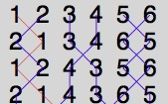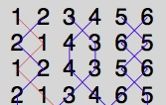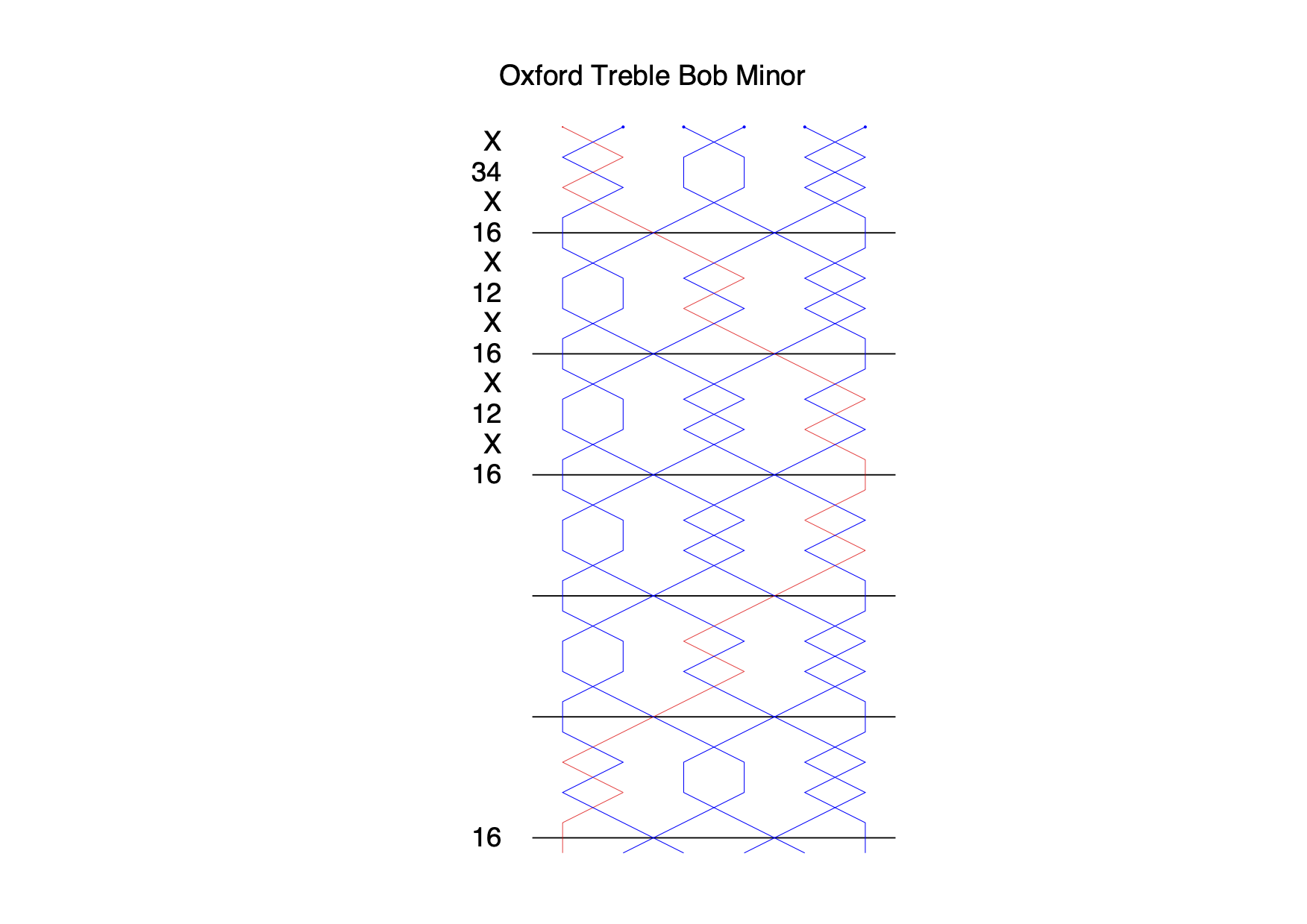33: Oxford TB Minor
Once you're happy ringing Kent, let's move on to Oxford.
Oxford differs from Kent only in the way that places are made when the treble is on the front. Whereas Kent begins with Kent places (34x34), Oxford begins with Oxford places (x34x).
Kent places in 34:

Oxford places in 34:

It's a subtle enough difference, but there are two big consequences:
- When you look at the rows, you'll see that the bells no longer arrive at the back and front or follow each other around in natural coursing order. For instance, you'll see that at one point, 3 and 4 dodge together at the back. Those two bells are not next to each other in natural coursing order (53246). This happens because when bells make a set of Oxford places, they turn around and head off in the opposite direction from the way they were going. If you compare the two little diagrams above, you'll see that the Oxford places flip 3 and 4 over. When those two bells come back together again at the end of the first lead, they are flipped back into their original position, so the lead head for the second lead is 142635, exactly the same as Kent. You can check this on the diagram below. The fact that the bells aren't in natural coursing order for most of each lead means that the ropesight is a little harder, and that it's significantly harder for the conductor to keep the method right if people get lost.
- Because the Oxford places flip a pair of bells over, you can't just cruise through them hoping for the best like you can in Kent. You have to get them right. Equally, it's essential not to try making Oxford places at the wrong moment. If you do, you'll quickly find yourself at the wrong end of the row. Just as in Kent, Oxford places are made when and only when the treble is dodging in 1-2. The act of turning round by making 3rds or 4ths is something new, and will need a bit of practice. Notice that if you are the bell making 4ths, both blows are over the same bell and that, if you're the bell truning around in 3rds, you head back out over the bell that you followed just before you made 3rds, i.e. the bell making 4ths over you. You may find it helpful just to ring the first lead on both 3 and 4 before you try a plain course.
Here's the grid for a lead of Oxford:

The grid can be summarised as follows:
- Places are made in 34 when the treble is in 1-2 (Oxford places are generally just referred to as 'places')
- 2nds is made when the treble is in 3-4
- 2nds is made when the treble is 5-6
- Whenever the treble hunts between dodging positions, all the other bells hunt too. (This is implicit in the definition of a Treble Bob method)
- Everybody hunts across the half lead (i.e. 1sts is made)
- Everybody hunts across the lead end (i.e. 6ths is made)
Check each of these points agains the grid to build up a picture in your mind of how the method works. Then have a look at the plain course of Oxford TB Minor and pick out the obvious features of the line. As with the diagram of Kent, I've added the line for the 4th

From the diagram, you can see that three of the five leads contain exactly the same work as Kent: 2nds place bell (the slow work), and 5ths & 6ths place bells. The only differences are in 3rds and 4ths place bell, where you need to make sure that you execute the places correctly at the start and end of each lead. Notice how the places turn you around in 3-4 and that, if you make 3rds at the start of the lead, you make 4ths at the end, and vice-versa. Between the places, you're just doing the usual work of treble-bob hunting but with plain leading on the front.
I hope you enjoy ringing Oxford as much as I do. As well as being a nice fluid method to ring (it's my go-to method for striking competitions) it forms the basis of so many other methods, so it's really worth getting to grips with it.



